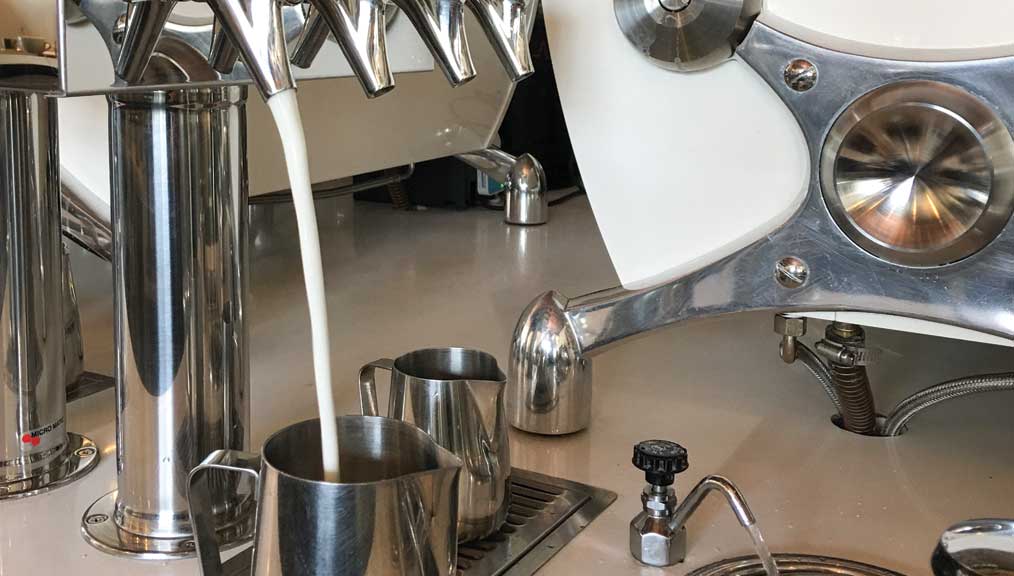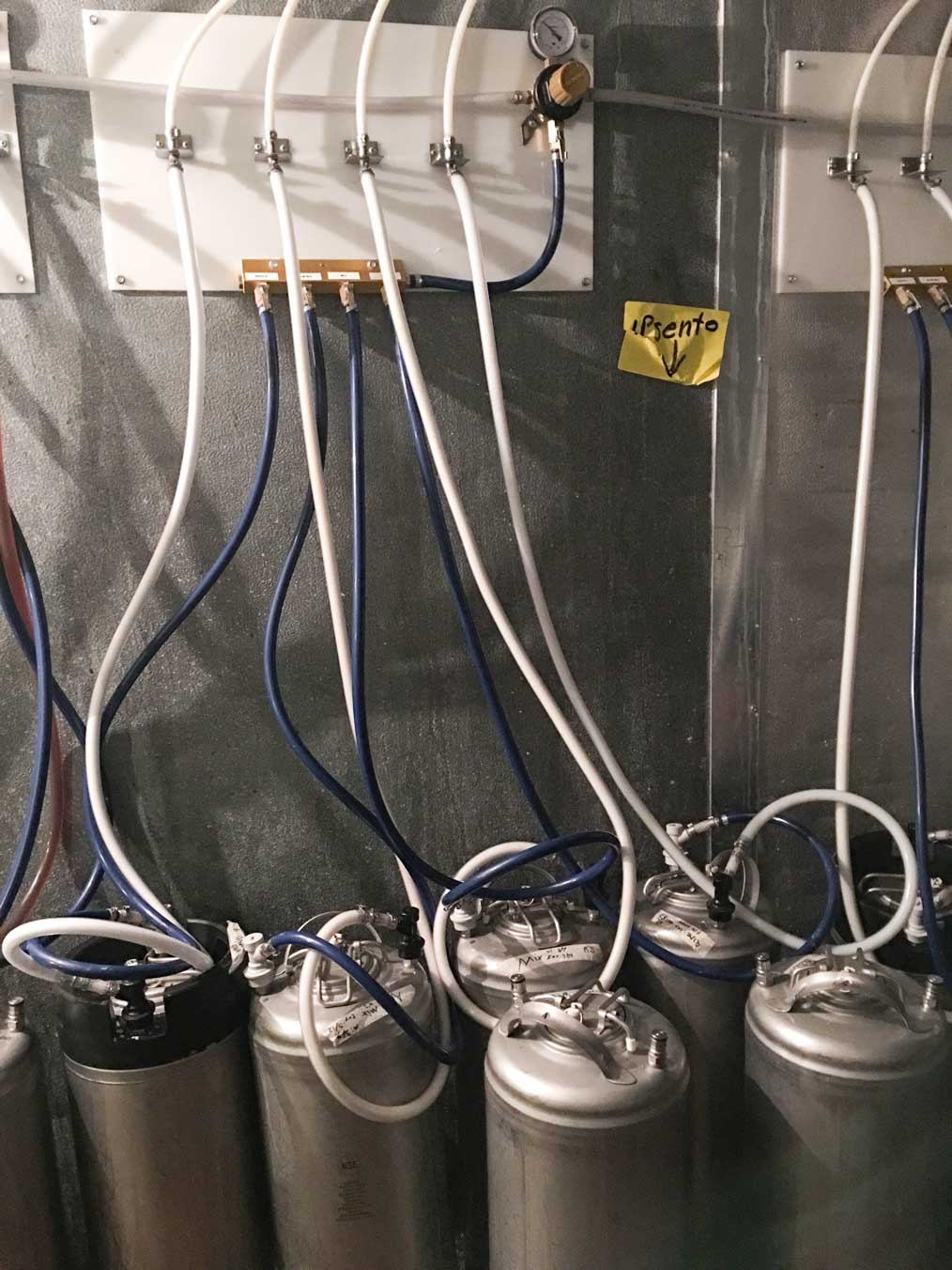[T]hink back to the last time you saw milk on tap in a coffee shop. Chances are you’ve only seen it once, if ever at all. Why are sightings in the wild so rare? Strict health codes can make these systems difficult to get past inspections, especially in the United States. Installing a system can also be dauntingly complex, from finding the right dairy partner, to allocating refrigeration space, to determining a proper cleaning regimen. Challenges aside, there are plenty of reasons to explore a tap system for your café—starting with the fact they’re just plain cool.
Milk tap systems come ready-made from companies like Juggler and Crathco. Juggler uses an under-counter refrigeration unit that feeds into countertop taps. Crathco calls on a more traditional dispensing system, utilizing an array of countertop tanks for liquid storage. A few café owners have taken a more engineered approach for streamlining the milk dispensing process, like Ipsento 606 in Chicago, Illinois. Ipsento uses beer tap lines and kegs (housed in the basement) to deliver four types of milk and milk alternatives to lines of taps next to their two Slayer espresso machines (below).
Is a milk tap right for your business? Great question. We’ve put together some considerations for why milk on tap might be the perfect fit for your café—or the biggest logistical nightmare you’ve ever faced. As you read, consider your shop’s daily traffic flow, the square-footage you’ve got to work with, and your staff roster.
GO FOR IT! Seven Reasons Milk Taps Are the S@#%
1) Efficiency on bar. With milk easily accessible from a tap on bar, baristas can multitask more easily, cutting down on the time it takes to put drinks in the hands of customers.
2) Ergonomics. While every café is different, it’s pretty common to store milk in fridges under the bar, which means lots of bending down for baristas. Tap systems eliminate this need.
3) Reduced waste. For cafés able to order milk in bulk, dispensers cut way down on plastic waste. Ipsento owner Tim Taylor says the taps also allow more precise measurements, which significantly reduces milk waste.
4) Aesthetics. Shiny tap heads look a heck of a lot prettier than plastic milk cartons, providing an added “crowd-pleaser” factor. Dispensing systems are visually streamlined, which appeals to the minimalist design aesthetic popular in many cafés.
5) Customer service. All that time spent fumbling over milk jugs can be channeled into customer interactions (and explaining all the cool features of your milk system).
6) Innovation. Integrating milk taps requires creativity and ingenuity. While many customers won’t notice their milk streaming from tap heads, the novelty of these systems creates an
attraction for coffee enthusiasts drawn to cool café features.
7) Collaboration. You’re going to need some help getting your system in place, which opens the door for new relationships. Ipsento partnered with Micromatic to wire their system; Taylor says the experience was a valuable learning opportunity for both parties.

OH, HECK NO! Seven Reasons Milk Taps are the Worst
1) Availability. The Juggler is still nearly exclusive to Australia; they’re working on electrical compliance and food safety standards for the United States. Beer tap systems likely require custom work from beer experts—like the glycol system Ipsento uses to chill their lines—or at least some serious consulting hours (see reason 3).
2) Footprint. More conventional systems (like the old-school Crathco) are designed for countertop positioning, hogging valuable real estate without enhancing your overall aesthetic. Out-of-sight systems still require storage space for kegs and refrigeration units.
3) Cost. Purchasing a tap system, expanding your back-of-house refrigeration, and ensuring FDA compliance isn’t cheap. Neither is continued work with technicians or consultants for systems that require troubleshooting or routine upkeep.
4) Milk packaging. Without high order volumes and a good relationship with your dairy partner, acquiring milk in the proper volume and packaging is difficult. The Juggler works with ten-liter bladders of milk, while Ipsento’s system uses five-gallon kegs. Ipsento’s original dairy partnership fell through, so they’re still hand-transferring single gallons to fill each keg.
5) Lifespan. Milk is perishable, so it’s risky to have a high volume of product unless you have the foot traffic to support fast turnover. Taylor says they’ve gotten a rhythm down with their kegs of skim and whole milk, but still have trouble with their almond and coconut milks, which have a short shelf life once opened.
6) Cleaning. Keeping milk taps clean is hard work. A system like Ipsento’s requires tubing to be regularly flushed, in addition to bi-weekly cleanings from equipment technicians.
7) Health code compliance. It’s fairly common for portions of tap lines to be unrefrigerated, which doesn’t fly well when milk is the liquid passing through (especially when trying to comply with US health codes). After doing extra work to bring your system to code (again, see number 3), there’s no guarantee of passing inspections.
We’re by no means milk tap naysayers (we happen to think they’re awesome), but we do want to bring pragmatism to the discussion table. For smaller cafés, it may not make any sense to undergo the expense of installing a tap system—grabbing milk from the reach-in fridge isn’t the most taxing part of a barista’s day, nor does it mandate a costly fix. But for high-volume cafés with square-footage to spare, a tap system may be a perfectly sensible solution to usher your business to new levels of efficiency and visual appeal.
Where to See a Milk Tap in Action
BEER TAP SYSTEM
Ipsento 606—Chicago, Illinois (US)
CHILL BRIGHT SYSTEM
Gossip Coffee—Astoria, New York (US)
MOO BAR
Danes Specialty Coffee—Queensland, South Australia, and New South Wales, Australia (AU)
THE JUGGLER
Phil & Sebastian—Calgary, Alberta (CAN)
Toby’s Estate—Barangaroo, New South Wales (AU)
Patricia—Melbourne, Victoria (AU)
Skittle Lane—Sydney, New South Wales (AU)
—Ellie Bradley is Fresh Cup‘s editor and Rachel Sandstrom Morrison is Fresh Cup‘s associate editor.

















